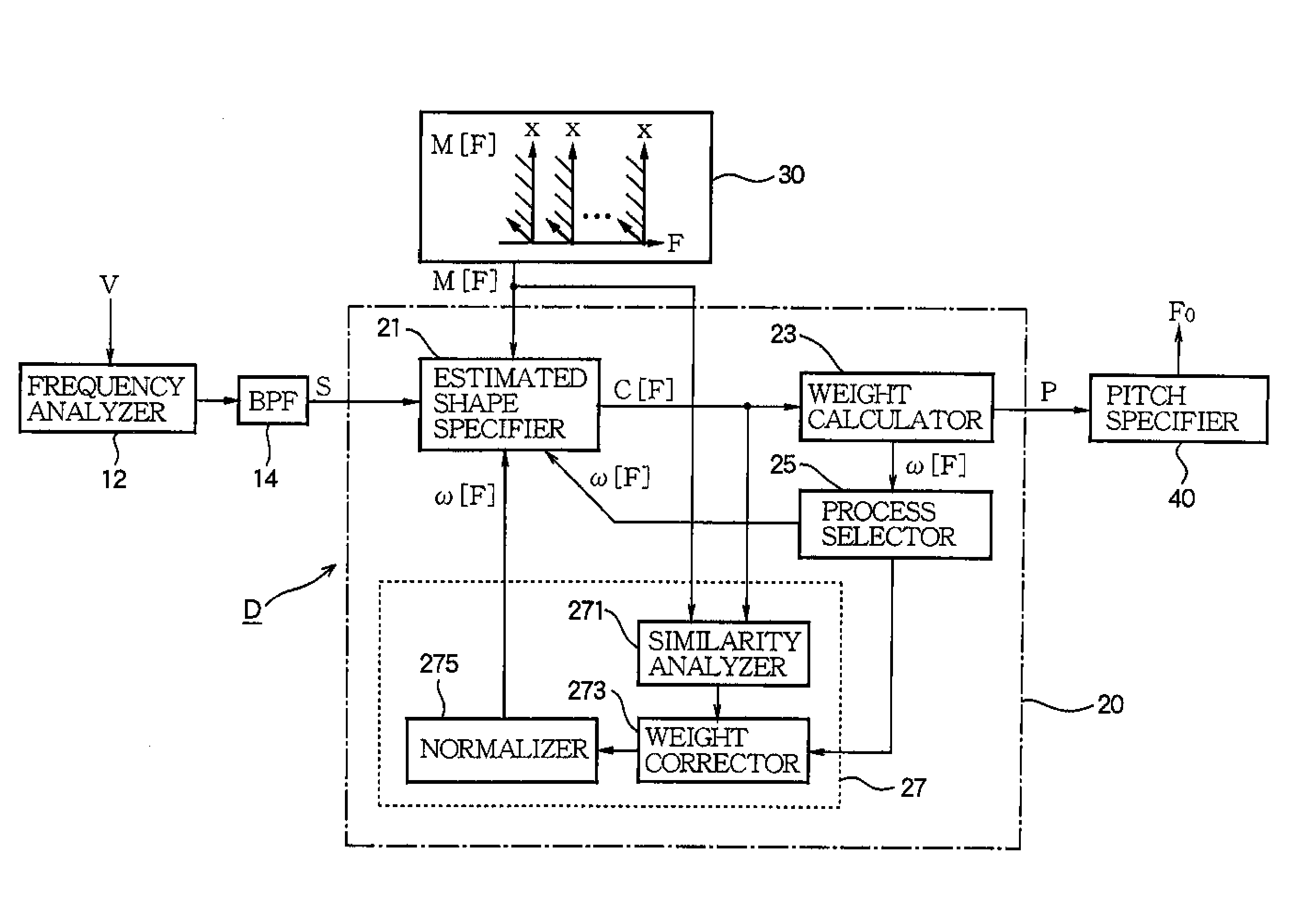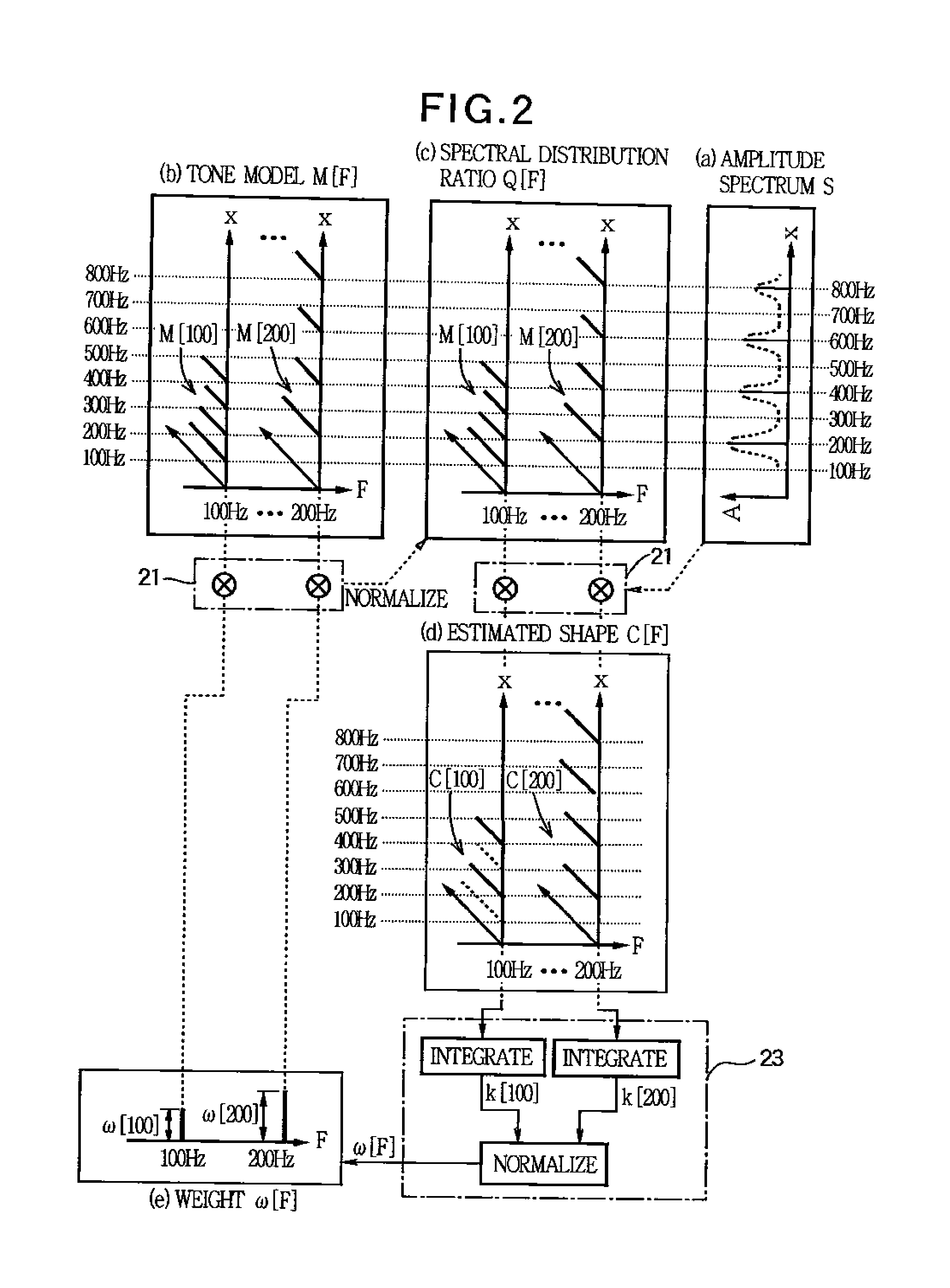Pitch estimation apparatus, pitch estimation method, and program
a technology of pitch estimation and pitch estimation method, applied in the field of pitch estimation of music sounds, can solve the problem of difficult to accurately extract only the fundamental frequency of a desired sound, and achieve the effect of accurately estimating the fundamental frequency of an audio signal
- Summary
- Abstract
- Description
- Claims
- Application Information
AI Technical Summary
Benefits of technology
Problems solved by technology
Method used
Image
Examples
embodiment 1
(1) MODIFIED EMBODIMENT 1
[0046]Although the weight ω[F] initially calculated for one frame is corrected at the weight corrector 273 in the configurations illustrated in the above embodiments, the timing when the weight ω[F] is corrected is optional. For example, it is also possible to provide configurations in which the weight ω[F] is corrected after a unit process is performed a predetermined number of times (one or more times). However, the configurations, in which the weight ω[F] is corrected at an initial stage as in the above embodiments, have an advantage of reducing the time (or the number of repetitions of the unit process) required to optimize the weight ω[F]. The number of times the correction of the weight ω[F] is performed on one frame is also optional. For example, configurations, in which the weight ω[F] is corrected each time the unit process is performed a predetermined number of times (one or more times), are also employed.
embodiment 2
(2) MODIFIED EMBODIMENT 2
[0047]Although the similarity index value R[F] is compared with the threshold TH in the configurations illustrated in the above embodiments, the method of determining whether or not to correct the weight ω[F] is changed appropriately. For example, the weights ω[F] of a predetermined number of fundamental frequencies F selected in order of increasing similarity between the tone model M[F] and the estimated shape C[F] (in order of decreasing similarity index value R[F]) may be corrected to zero.
[0048]In addition, although weights ω[F] corresponding to ghosts are changed to zero in the configurations illustrated in the above embodiments, the method of correcting the weights ω[F] is not limited to it. That is, weights corresponding to ghosts, among weights ω[F] output from the ghost suppressor 27 to the estimated shape specifier 21, only needs to be reduced to values less than the weights ω[F] calculated by the weight calculator 23. Accordingly, in addition to t...
embodiment 3
(3) MODIFIED EMBODIMENT 3
[0050]The KL information quantity is just an example of the similarity index value R[F]. For example, a Root Means Square (RMS) error between the tone model M[F] and the estimated shape C[F] may also be calculated as the similarity index value R[F]. In addition, although the similarity index value R[F] approaches zero as the similarity between the tone model M[F] and the estimated shape C[F] increases in the cases illustrated above, the similarity index value R[F] may be calculated such that the similarity index value R[F] approaches zero as the similarity between the tone model M[F] and the estimated shape C[F] decreases. That is, in the present invention, the method of calculating the similarity index value R[F] is optional and any configuration suffices if it reduces weights ω[F] of fundamental frequencies F whose tone model M[F] and estimated shape C[F] have low similarity.
PUM
 Login to View More
Login to View More Abstract
Description
Claims
Application Information
 Login to View More
Login to View More - R&D
- Intellectual Property
- Life Sciences
- Materials
- Tech Scout
- Unparalleled Data Quality
- Higher Quality Content
- 60% Fewer Hallucinations
Browse by: Latest US Patents, China's latest patents, Technical Efficacy Thesaurus, Application Domain, Technology Topic, Popular Technical Reports.
© 2025 PatSnap. All rights reserved.Legal|Privacy policy|Modern Slavery Act Transparency Statement|Sitemap|About US| Contact US: help@patsnap.com



